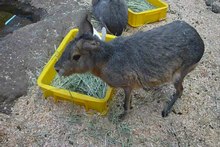Mara (mammal)
This article needs additional citations for verification. (November 2011) |
| Mara Temporal range: Montehermosan-Recent
~ | |
|---|---|

| |
| A male Patagonian mara | |
| Scientific classification | |
| Kingdom: | Animalia |
| Phylum: | Chordata |
| Class: | Mammalia |
| Order: | Rodentia |
| Family: | Caviidae |
| Subfamily: | Dolichotinae Pocock 1922 |
| Genus: | Dolichotis Desmarest 1820 |
| Species | |
| |

| |
| Approximate range of the maras | |
The maras are a genus (Dolichotis) of the cavy family of rodents. They are the sole extant representatives of the subfamily Dolichotinae.[1] These large relatives of guinea pigs are common in the Patagonian steppes of Argentina, but also live in Paraguay and elsewhere in South America. Patagonian maras are the fourth-largest rodent in the world, after the two species each of capybaras and beavers, and the large species of porcupines, reaching about 45 cm (18 in) in height.
Etymology[]
Dolichotis means "long-eared" (from dolicho- "long" and ōt- "ear") in Ancient Greek.[2]
Description[]
Maras have stocky bodies, three sharp-clawed digits on the hind feet, and four digits of the fore feet. Maras have been described as resembling long-legged rabbits. Patagonian maras can run at speeds up to 29 km/h (18 mph). The Patagonian species can weigh over 11 kg (24 lb) in adulthood. The average weight of adult male Patagonian maras is 8.3 kg (18 lb) and in adult females is 7.75 kg (17.1 lb).[3] Meanwhile, the Chacoan mara, though still large for a rodent, is much smaller, weighing around 1 to 3 kg (2.2 to 6.6 lb).[4]
Most maras have brown heads and bodies, dark (almost black) rumps with a white fringe around the base, and white bellies.
Maras may amble, hop in a rabbit-like fashion, gallop, or bounce on all fours. They have been known to leap up to 6 ft (1.8 m).
Maras mate for life, and may have from one to three offspring each year. Mara young are very well-developed, and can start grazing within 24 hours. They use a crèche system, where one pair of adults keeps watch all the young in the crèche. If they spot danger, the young rush below ground into a burrow, and the adults are left to run for it.[3]
Species[]
Two extant and two extinct species of maras are recognized:
| Image | Scientific name | Common name | Distribution |
|---|---|---|---|
 |
Dolichotis patagonum | Patagonian mara | Argentina |
 |
Dolichotis salinicola | Chacoan mara | Argentina, Paraguay, and Bolivia |
- Fossil species
- †D. intermedia Ameghino, 1889
- †D. platycephala Ameghino, 1889
Fossils are known from Argentina:[5]
Interaction with humans[]
Patagonian maras are often kept in zoos or as pets, and are also known as "Patagonian cavies" or "Patagonian hares". They can be quite social with humans if raised with human interaction from a young age, though they avoid people in the wild. Maras may even change their habits from coming out in day to becoming nocturnal, simply to avoid social interaction. In 2021 they had young in Leningrad Zoo of Saint Petersburg, Russia.[6]
Gallery[]

Patagonian mara at the Wildlife Ranch in San Antonio, TX

A pair of Patagonian maras at the Melbourne Zoo

Close-up of a Patagonian mara
Mara at
References[]
- ^ Woods, C.A.; Kilpatrick, C.W. (2005). "Infraorder Hystricognathi". In Wilson, D.E.; Reeder, D.M (eds.). Mammal Species of the World: A Taxonomic and Geographic Reference (3rd ed.). Johns Hopkins University Press. p. 1555. ISBN 978-0-8018-8221-0. OCLC 62265494.
- ^ "Dolichotis". Oxford English Dictionary (Online ed.). Oxford University Press. (Subscription or participating institution membership required.)
- ^ a b Campos, C. M., Tognelli, M. F., & Ojeda, R. A. (2001). Dolichotis patagonum. Mammalian species, 2001(652), 1-5.
- ^ Campo, D. H., Caraballo, D. A., Cassini, G. H., Lucero, S. O., & Teta, P. (2020). Integrative taxonomy of extant maras supports the recognition of the genera Pediolagus and Dolichotis within the Dolichotinae (Rodentia, Caviidae). Journal of Mammalogy, 101(3), 817-834.
- ^ Dolichotis at Fossilworks.org
- ^ "В Ленинградском зоопарке родились патагонские мары". spbdnevnik.ru (in Russian). Retrieved 2021-10-21.
External links[]
| Wikimedia Commons has media related to Dolichotis. |
| Wikispecies has information related to Dolichotis. |
- Patagonian Mara - National Zoo| FONZ (via archive.org)
- Cavies
- Extant Miocene first appearances
- Mammals of Argentina
- Mammals of Bolivia
- Mammals of Paraguay
- Mammals described in 1820
- Taxa named by Anselme Gaëtan Desmarest




